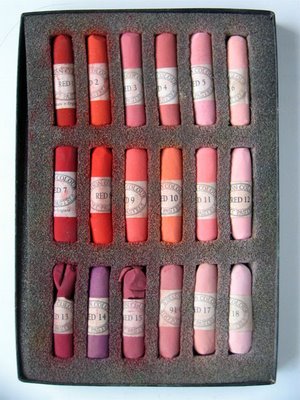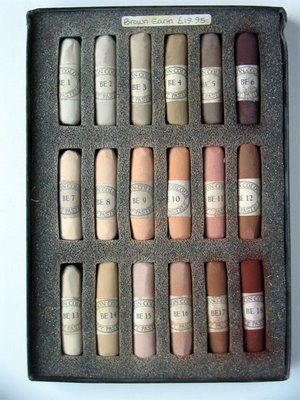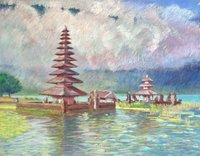

 Some technical information today in the sixth of this series of posts about Unison Pastels.
Some technical information today in the sixth of this series of posts about Unison Pastels.John Hersey, an artist used to working with charcoal, created the pastels as a result of his enquiry into the nature and properties of colour.
The pastels appeal to colourists as they provide strong pigment colour with a soft pastel performance. The pastels are pigment rich, have very little binder and are developed as a series of hues. Many of the pastels are pure and single pigments which are then blended with a little white (chalk) to create the tints.
"The pigments used are the traditional ones: Cadmium (with a limit of 0.01% or 100ppm soluble Cadmium), Cobalt, Oxide of Chromium, Viridian, the Ultramarines, Cobalt Chromes, the natural and synthetic Iron Oxides, Titanium Dioxide and China Clay. These colours have stood the test of time and are very durable and lightfast."The sets are based on Hersey's theory about colour integration hence the title - Unison. The cycles of hues and tint variations were influenced by the light in Northumberland which show the colours of nature very clearly. For me, this approach also explains why - in my experience - all the colours work so well with one another - as demonstrated by my plein air painting of the lake temple, Pura Ulun Danu Bratan, near Bedugal in Bali (below) which mixes shades from the the red earth and red sets with blues, blue greens and yellow greens.

Unison pastels are hand-made in Northumberland. The process used to produce them means they are considerably softer than many of those made in factories. Rather than being compressed and extruded from a pastel mixing machine and chopped into uniform lengths by another machine, each stick is hand-rolled and air-dried. Consequently they're not a uniform shape although each stick measures approximately 2-1/8" long × 5/8" diameter (54 mm × 16 mm). Pastel colour sets are then packaged in a robust black cardboard box with good quality foam insert which provides a protected home for 18 pastels.
My sixth post in this series combines the Red, Red earth and Brown Earth pastels. I have to confess I was a bit worried about how to cover the brown ones as I don't use them a lot. But they seem to fit in happily next to the Red Earth set. One of the worries of many people, on the other hand, is how some pigments cope with light over time. I have Devon Camellias #1 under glass on the wall of my sitting room for about 12 years with no obervable deterioration. The reality is that pastels are lightfast rather than fugitive if pigments are well chosen.
 Artwork: click on the small images to see a larger painting
Artwork: click on the small images to see a larger paintingPura Ulun Dana Bratan 19.5" x 25.5"
Devon Camellias #2 19.5 x 25.5"
Technorati tags: art , Bali , camellia , Devon , painting , pastel , pastels , Unison
Katherine,
ReplyDeleteYou ahve one of the best blogs I have seen and I enjoy getting the emails.
Linda Blondheim
www.lindablondheim.com
Thanks Linda - and coming from somebody who I regard as one of the best artists I know for sharing all you've learned from 30 years of painting I take that as praise indeed!
ReplyDeleteThanks again!
I love your still lifes with floweres, Katherine. You have a very special touch and I agree, your blog is a treat to read.
ReplyDeleteI love pastels!
ReplyDeleteoooo those colors are making me giddy! Although they're earth tones they sing to me of seashells!
ReplyDeleteYou've sold me on the Unisons Katherine. Thankyou for presenting such detailed information.
...chuck
Thanks for all the comments. Chuck - I shall look forward to seeing pigment rich pastel seashells! :)
ReplyDeleteI love the Unison eye candy that you have been putting on your blog Katherine. I don't own many as they are so expensive to buy in Australia though slowly building my colours up. Your information on them is helping me to make wise choices when it comes to choosing my colours and I thank you!
ReplyDeleteI was looking for Unison Pastels and I discovered your wonderful blog, Katherine. Congratulations, what a lot of information about art ! Your works are simply excellent !
ReplyDeleteThanks Kate
ReplyDelete